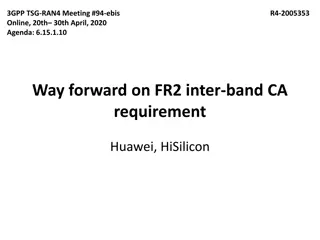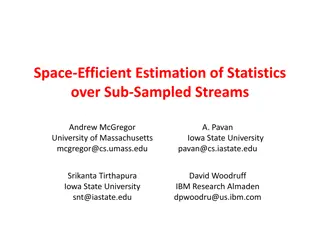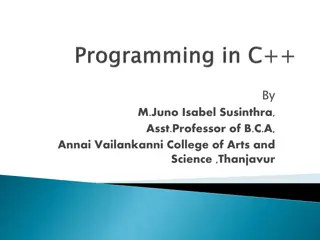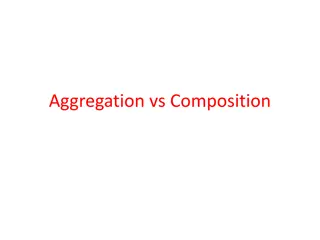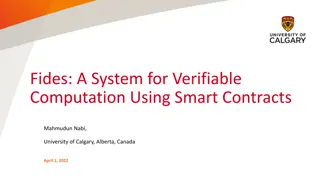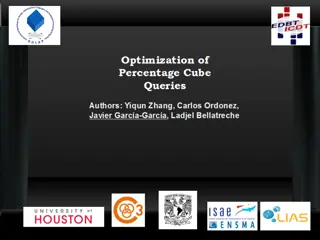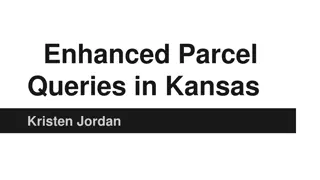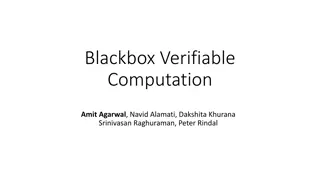Publicly Verifiable Grouped Aggregation Queries on Outsourced Data Streams
Explore the challenges and solutions for publicly verifiable grouped aggregation queries on outsourced data streams, focusing on security, verification, and cloud computing. The research discusses how to handle large amounts of data using small memory components and emphasizes the importance of data security in cloud-based processing.
Download Presentation

Please find below an Image/Link to download the presentation.
The content on the website is provided AS IS for your information and personal use only. It may not be sold, licensed, or shared on other websites without obtaining consent from the author.If you encounter any issues during the download, it is possible that the publisher has removed the file from their server.
You are allowed to download the files provided on this website for personal or commercial use, subject to the condition that they are used lawfully. All files are the property of their respective owners.
The content on the website is provided AS IS for your information and personal use only. It may not be sold, licensed, or shared on other websites without obtaining consent from the author.
E N D
Presentation Transcript
Publicly verifiable Grouped Aggregation Queries on Outsourced Data Streams Suman Nath Microsoft Research, Redmond Sensing and Energy Research Group Cryptographer Alert Ramarathnam Venkatesan Microsoft Research India Redmond
Verification can not use secrets TO UNTRUSTED COMPONENTS Publicly verifiable Grouped Aggregation Queries on Outsourced Data Streams Cryptographer Alert Too much data Must use small memory components BY UNTRUSTED COMPONENTS Advent of cloud, we will see this more and more
Databases, Data Engineering, Data X. B.C A.C A.C Year of your choice 2011+x
Outline Contexts and Goals Our Solution: DiSH Various Extensions Results Verification time should be comparable to downloading time
In-house Stream Processing Clients (Untrusted) Results of continuous query Data Owner Query DataStream Result
Motivation Sensor network example E-bay style example Part of a bigger set of queries to be supported Max, min, average, top-k . Focus:Stream version, not the stored DB
Motivating Examples Server Owner Histogram of <sensing event, time> Histogram of <buyer demographic, product id> Client Sensor network Online marketplace
tasks Move the computations to cloud (untrusted server) A front end processing, processing on encrypted data This case, Small client, small memory Streaming data Security modeling Excellent Problems in the Data Base Setting Most of them Can not be Outsourced to Cryptographers as a black box
Outsourced Stream Processing Data owner forwards data stream to Server Clients (Untrusted) Server (Untrusted) Results of continuous query Client can verify results with a small digest Data Owner DataStream Small memory Clients query Server and gets results
Model Data owner forwards data stream to Server Clients query Server and gets results Client can verify results with a small digest Public verifiability Clients (and Server) are untrusted, Clients can collude with Server Unlike most previous work Solutions depend on aggregation functions
Grouped Aggregation Query Histogram or Group-by, Sum queries Aggregates Groups Stream of tuples <gi,vi> On seeing a tuple <gi,vi>, increment the group gi by value vi Return sums for all groups on demand SELECT product_id, demographic_id, SUM(purchase_volume) FROM purchase_stream GROUP BY product_id, demographic_id
BTW: Crypto Preferred Symbol for an adversary Security Goals Dynamic digest T w Server (Untrusted) <gi,vi> Result Outsourced DataStream DataStream Clients (Untrusted) T Data Owner Digest Client can use T to determine if w is correct
Desired properties of T Should be small and discriminative Communication efficiency Should be incrementally computable Works on streaming data Should not reveal owner s secret Enables public verifiability
Outline Contexts and Goals Our Solution: DiSH Various Extensions Results
Prior Work (Yi et al. TODS09) Result from server: w =(?0 ,?1, ,?? 1 ) =? True result: r= (?0 ,?1, ,?? 1 ) Data Owner 1. Secret: Zp, p is a large prime 2. Incrementally compute:T ? = ? 1?0? 2?1 (? ?)?? 1 3. Send to Client: and T(r) rk: Sum of group k Not publicly verifiable because the secret is needed for verification Client 1. Compute:T ? = ? 1?0? 2?1 (? ?)?? 1 2. Check: T(r) = T(w) ? We will use Public Key Crypto. Computationally Costlier
Structure of DiSH DiSH: Digest for Streaming Histogram gi :Group id vi :Increment Secret Initialized once Updated with each tuple <gi,vi > in stream (Updated with Secret and <a,b>) Digest Publish Encrypted Secret from server Digest Digest ?
Security Analysis , Discrete Log Problem: Given ?, ?? find ? such that ??= (??? ?) Conjectured to be hard Basis for cryptographic systems in wide use Prime must be long (e.g. 1024bits) Can use elliptic curve versions. Idea: If a Server can efficiently produce a fake result that matches owner s DiSH, it can solve the Discrete Log Problem efficiently as well. (Proof given in paper)
This is the discrete logarithm problem; considered hard for large values of prime. There is also an elliptic curve version, whose use is nearly identical.
How to use the discrete log We now outline the idea Linear Algebra in the exponents is HARD
A terribly easy problem to solve: given (?1,?2,?? ) (?1,?2, ,?? 1 ) Pick any way you want Adjust ?? ?? ? ?? 0= 1 Easy linear algebra ??? ?? THIS becomes Terribly hard if we are given only Linear Algebra in the exponents is HARD
All multiplications are modulo the prime p Moral: While verification, Don t work with (?1,?2, ?? ) Work with PROVE THAT AN ATTACKER, TO FAKE A DIGEST, MUST SOLVE THE PROBLEM THE LEMMA SAYS IS HARD (assuming THE DISCRETE LOGARITHM PROBLEM IS HARD)
The Basic Protocol Data Owner Too large to send to Client 1. Initialize secrets: i for each group i 2. On seeing a tuple < gi,vi >: T = T . ? ?? ?? (modulo p) 3. Send to Client T and ? ?, for each group i Incremental computation Client cannot guess ? from ? ?; discrete log problem Client 1. Get result r from Server 2. Compute: T = ?=0 3. Check if T = T ? 1??? ??
The Optimized Protocol > #groups Data Owner 1. Secrets: A, B, and ?0, ?1, , ?? 1, where ? = log(?) 2. Deterministically compute i from the secrets 1. ? ? = ?=0 2. ??= ?? ? + ? 3. On seeing a tuple < gi,vi >: T = T . ? ?? ?? (modulo p) 4. Send to Client T,??,???0,???0, ,???? 1 ? 1????,??= ?? ??? ?? ? Client 1. Get result r from Server 2. Compute: T = ?=0 3. Check if T = T ? 1(( ?|??=1????)??)??
Security Analysis If Server produces ? ? that matches DiSH of ? ? 1 (( ? 1 ?|??=1????)??)??= ?|??=1????)??)?? (( ?=0 ?=0 ? 1 ? 1 ? ? ? ??= ? ?? ??????? ?/? Nonzero ?=0 ?=0 ????: ??,???0,???1, ,???? 1,??????? ?/? To solve DLP: ? = ?? ????: ?1,???0,???1, ,???? 1,??????? ?
Outline Contexts and Goals Our Solution: DiSH Various Extensions Results
Queries on Subset of Groups Client 1 Client 2 Dynamic Subset Queries: Subsets are not known a priori Our result: No limited-memory signature can verify arbitrary subsets, assuming Memory is too small to encode entire result Data generated by a stochastic process
Static Subset Queries Option 1: one signature per client Update cost O(#clients), Memory O(#clients) Option 2: exploit composability of DiSH T(?1+ ?2) = T ?1 T(?2) Three queries Four DiSH on disjoint sets of groups Update cost O(1) since each tuple updates one DiSH Memory O(#clients)
Concurrent Queries with Multiple Grouping Schemes Select Sum(sales) Group By customer_age Select Sum(sales) Group By customer_income A client has queries on u grouping schemes Na ve solution: maintain u DiSH O(u) update, O(u) memory, O(u) verification costs Optimized: maintain 1 DiSH with all groups O(u) update, O(1) memory, O(1) verification costs
Other Extensions due to Composability of DiSH Distributed data collection Maintain DiSH at distributed sources, merge at a central place (Hopping) sliding window One DiSH per each hopping window Merge to get DiSH for full window Tolerating communication losses See paper 1 Week New data Old data 1 day
Outline Contexts and Goals Our Solution: DiSH Various Extensions Results
Experimental Setup Desktop PC with Intel Core 2 Duo 2.5 GHz CPU 4GB RAM GNU C++ and NTL library 512-bit prime number Typo in the paper: 64-bit 64 bit discrete logarithm is awfully easy.
DiSH Overheads Owner: Client: More than 30K tuples per second Verification time ~1sec Comparable to result download time
Subset Query Results A Bing click log Each Client makes three queries, on 300 random groups Select Count(*) Group by geo_location Select Count(*) Group by time-of-day Select Count(*) Group by clicked_business 1 Query/client 3 queries/client Unoptimized Optimized Update time (at Owner) ~80 s ~ 823 s (10 clients) ~ 8.2ms (100) ~ 81.1ms (1000) ~81 s Verification time/query (at Client) ~15 sec ~ 30 s ~ 12 s
Conclusion We proposed DiSH, a small digest to verify correctness of streaming histogram queries Models of trust in the new scenarios And a few extensions Soundness based on Discrete Log Problem Future speed up may come from using other hard problems Experiments show efficiency











